Just days after ‘The Accursed Share’ opened at the Talbot Rice Gallery in mid March, JP Morgan Chase warned of the threat of a ‘Minsky Moment’, an economic crash caused by the level of lending exceeding what investors can pay off. Once these are the prevailing conditions, a minor event can send world economies into meltdown. It’s hard to leave this exhibition about debt without feeling that these conditions have been in place for centuries already.
The exhibition takes its title from what curator James Clegg describes as ‘one of the strangest studies of economics’, written by Georges Bataille. Any economy, the French philosopher argues, will produce an excess or ‘non-recuperable’ output. This must either be spent luxuriously (on, for example, the arts), or is otherwise destined to fuel destruction (war). ‘If we do not have the force to destroy the surplus energy ourselves,’ Bataille argues, ‘it cannot be used, and, like an unbroken animal that cannot be trained, it is this energy that destroys us; it is we who pay the price of the inevitable explosion.’
Although the artworks often feel disconnected from one another, and although the artists are from all over the world, they all yearn for a planet that values human care and repair over profit. This yearning is best represented by the modest yet clearly painstaking weavings of Hana Miletic, whose Materials series is hung throughout the rooms of the gallery.
The exhibition begins with an installation by Sammy Baloji: 50 copper shell-casings potted with plants from the Democratic Republic of the Congo. Towards the corner, the floor turns to steps, imitating a postcard found by the artist, which depicts German munitions on the grand staircase of a town hall in Nancy in north-east France. While Baloji emphasises the damage that makes his collection possible, the glimmer of the shell casings combined with the greenery inside reminds us that oppressive structures can still include opportunities for resistance .
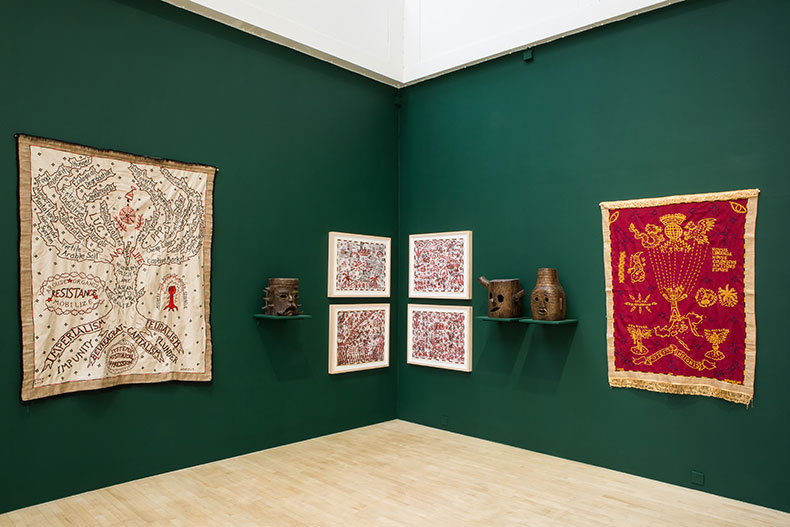
Installation view of works by Cian Dayrit in ‘The Accursed Share’ (2023). Photo: Sally Jubb; courtesy Talbot Rice Gallery, University of Edinburgh
On the walls opposite are tapestries by Cian Dayrit. Described as ‘counter-cartography’, they use maps and slogans to represent how the economy works in the Philippines and the wider world. Bearing more than a resemblance to the union banners you’d see at the Durham Miners’ Gala, the tapestries are more overtly political than Baloji’s work, but their golden threads and depictions of greenery chime with the nearby shell casings turned into planters. Tree of life in a state of decay and rebirth (2019) is a more muted work, consisting of brown lines on an off-white sheet; the few red threads stand out all the more. A black liquid drips into the trunk of the tree, forming the vertical letters of ‘DEBT’, before the two colours are combined in the lettering at the roots: ‘IMPERIALISM’, BUREAUCRAT-CAPITALISM’ and ‘FEUDALISM’.
A triptych by the Berlin-based collective terra0 is more frustrating. It depicts a forest across three panels of layered ‘Lidar’ – light detection and ranging scans – above photographic prints. The wall text tells us that this is ‘an ambitious, self-evolving project’ that ‘seeks to imagine the possibility of an autonomous, sentient forest that can manage its own legal and financial affairs’, though there is little prospect of divining this from the work itself. However much it is marked as a work in progress, the rather unsatisfying static product displayed here says more about curating than it does about its stated subject. Thematic group exhibitions like this one seek to both tap into and shape the zeitgeist, but require a level of explanation, which, in this case, seems to detract from viewing terra0’s work on its own merits.
In a round room, below a glass domed roof, we see a more accomplished attempt at synthesising work within and outwith the gallery. Goldin+Senneby’s The Plot (Utopia Bloemen) (2018) plays on how the word ‘plot’ can signify both land and story. The Stockholm-based duo acquired a Belgian wasteland above a derelict colliery, and have rendered the fossils they found there in coal dust on vaseline-coated walls. Centred around an artist’s box, Goldin+Senneby’s work is as interested in its own process as terra0’s, but it feels far less self-absorbed.
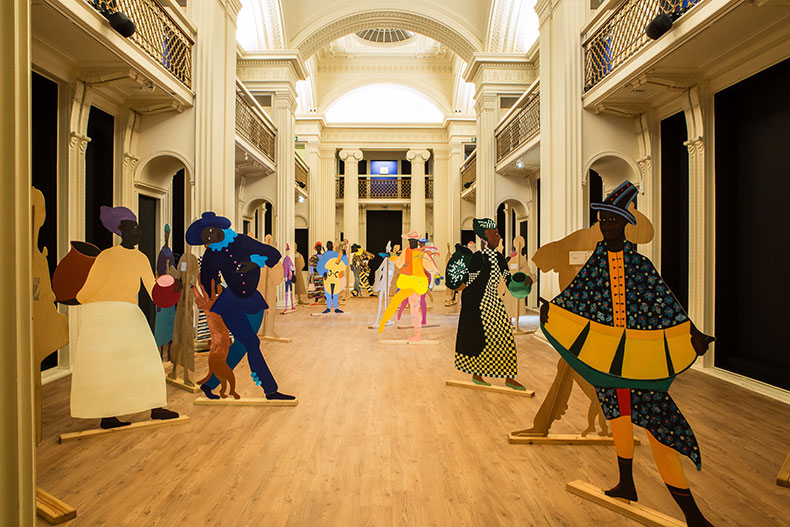
Naming the Money (2004), Lubaina Himid. Installation view of ‘The Accursed Share’. Photo: Sally Jubb; courtesy Talbot Rice Gallery, University of Edinburgh
Turner Prize-winner Lubaina Himid has positioned painted cut-out figures among classical pillars and an adventurous soundtrack that combines jazz and baroque with moments of narration. The figures of Naming the Money each carry a ‘balance sheet’ on their rear, with a haiku-like poem featuring an African and European name for each. Each poem ends with a line that mentions with an element that provides personal consolation. In the case of The Viola de Gamba Player, for instance, the balance sheet concludes: ‘But I have my songs.’
In Reverse Shot (2022) a film by Marwa Arsanios (from her series Who Is Afraid of Ideology?) farmers and eco-feminists in Lebanon create new common land by exploiting a legal loophole. The Arabic word for commons, featured in Arsanios’s film, is ‘waqf’, meaning a ‘permanent gift to society’. The need for global economic justice is a thread which runs, with occasional interruptions, throughout the show, but so does the notion that the sum of human labour will always be more than can be paid back.
‘The Accursed Share’ is at Talbot Rice Gallery, Edinburgh, until 27 May.
Unlimited access from just $16 every 3 months
Subscribe to get unlimited and exclusive access to the top art stories, interviews and exhibition reviews.

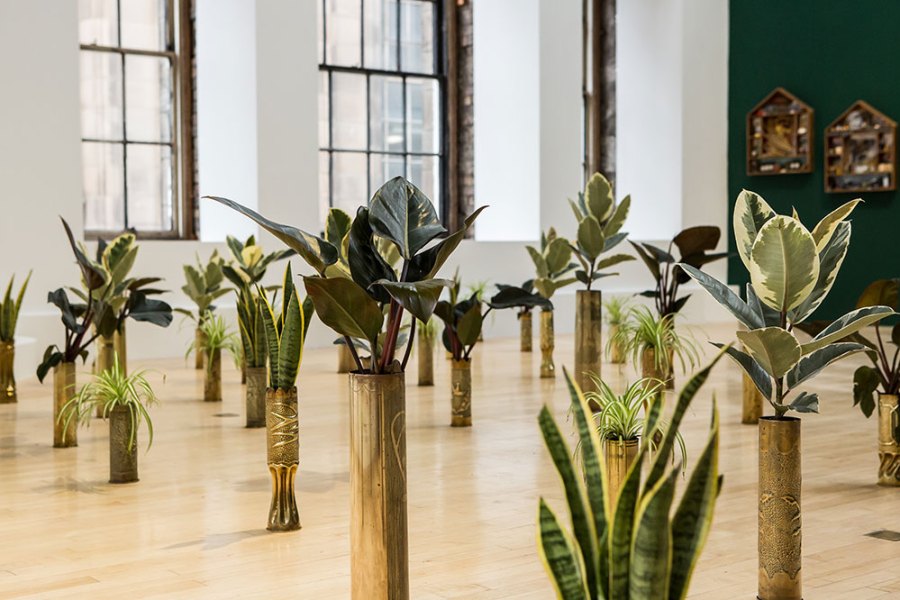
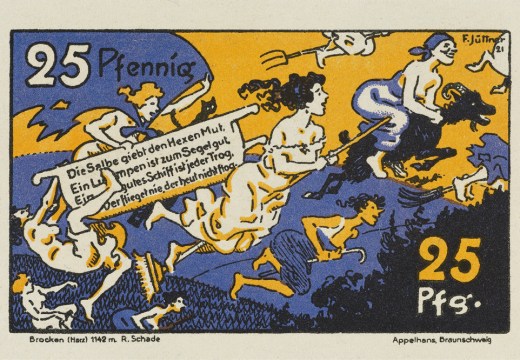

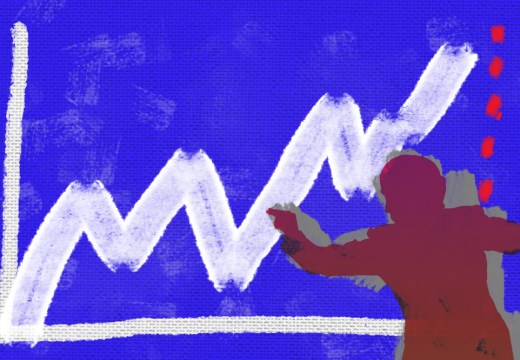









![Masterpiece [Re]discovery 2022. Photo: Ben Fisher Photography, courtesy of Masterpiece London](http://www.apollo-magazine.com/wp-content/uploads/2022/07/MPL2022_4263.jpg)
It’s time for the government of London to return to its rightful home